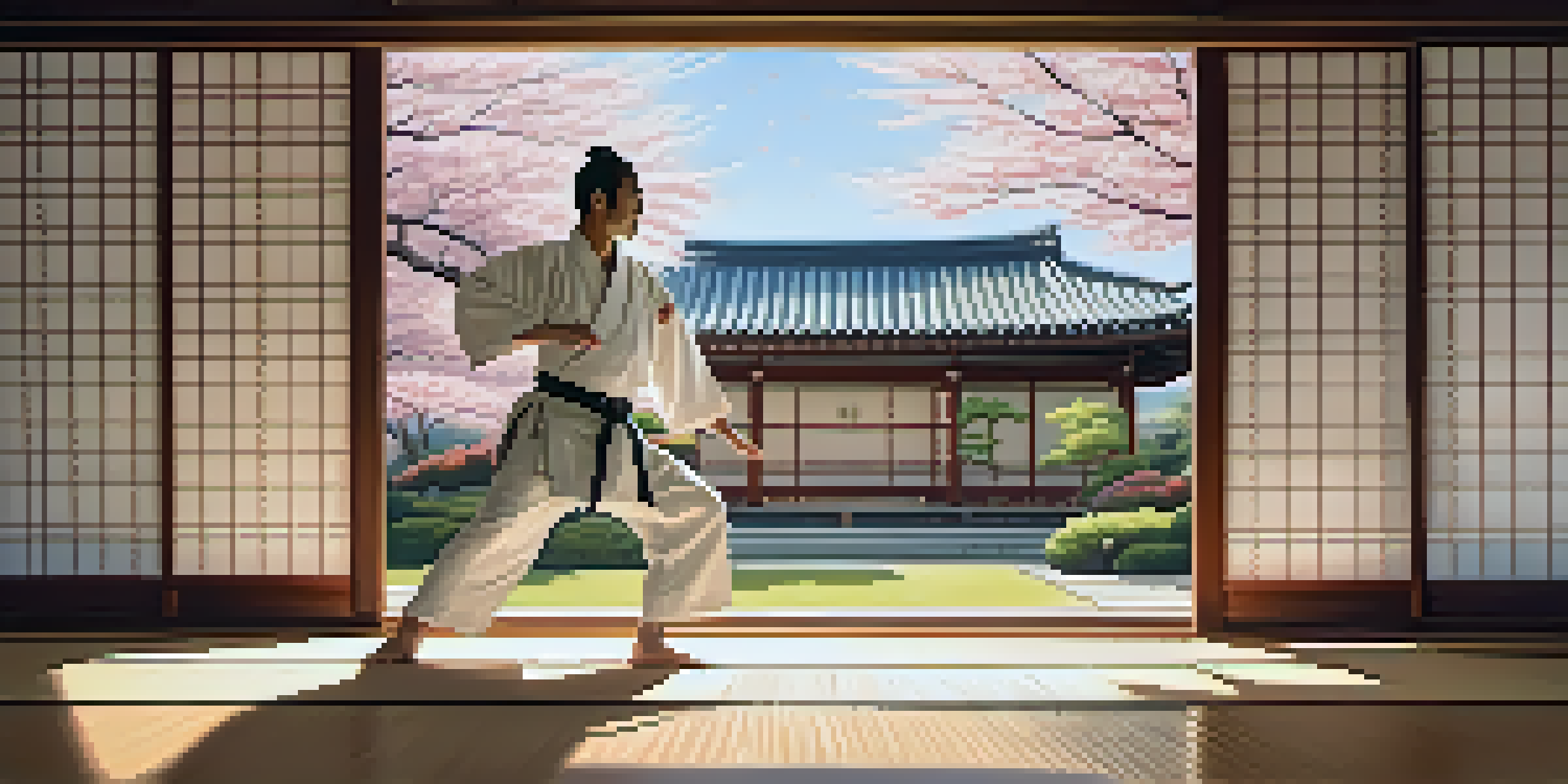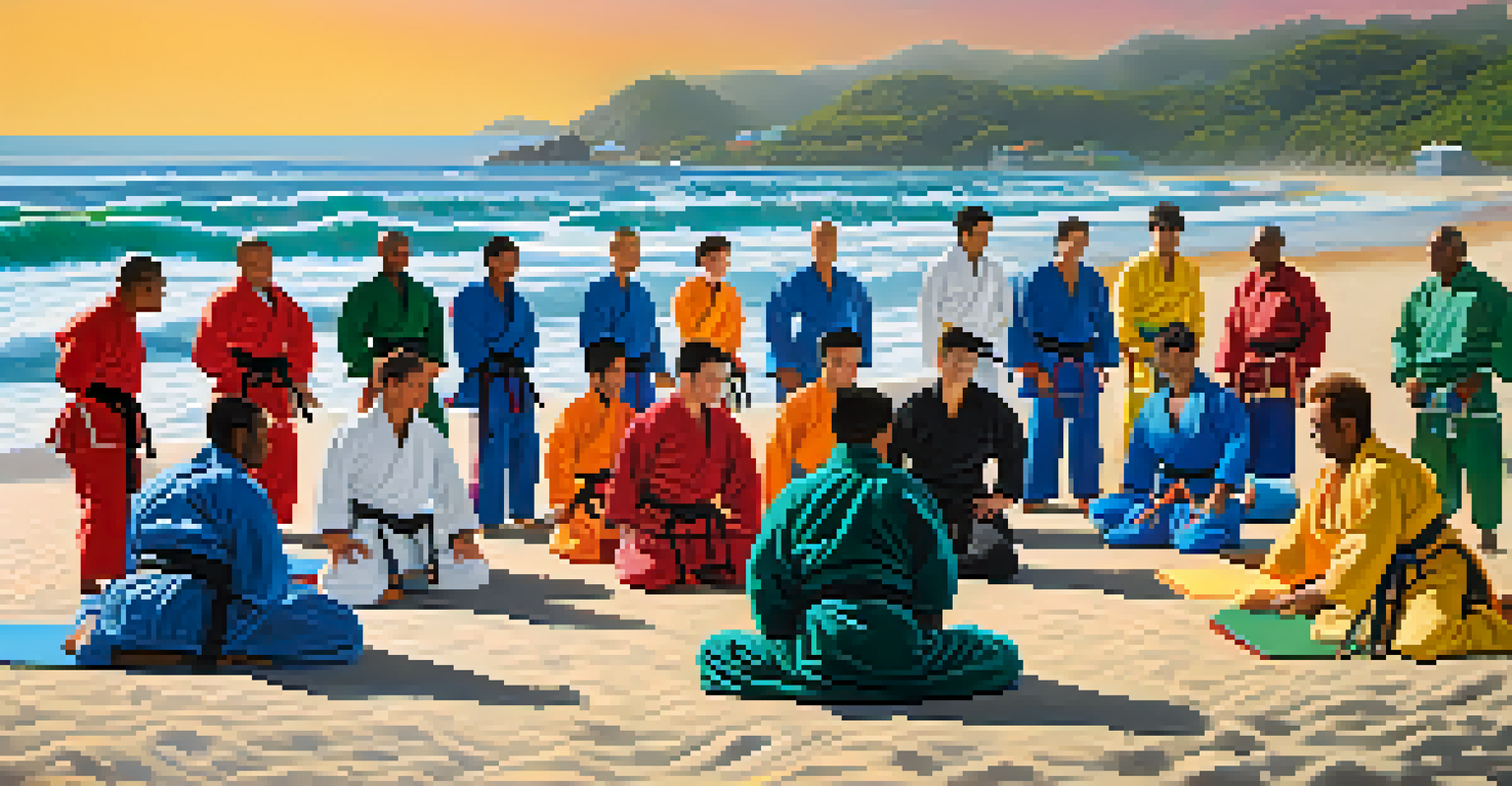Martial Arts Styles as Reflections of Cultural Identity

Understanding Martial Arts as Cultural Expressions
Martial arts are not just physical practices; they are deeply rooted in the cultures from which they originate. Each style reflects the values, beliefs, and social norms of its community, acting as a mirror for cultural identity. Just as a painting captures the essence of an artist's emotions, martial arts encapsulate the spirit of a society.
Martial arts are not just about fighting; they are about understanding the culture and history behind them.
For instance, Brazilian Jiu-Jitsu emphasizes adaptability and intelligence, mirroring Brazil's diverse and resourceful culture. Similarly, the discipline and respect inherent in traditional Japanese martial arts showcase the country's historical importance placed on honor and integrity. This connection between culture and martial arts highlights how these practices are shaped by their environments.
Therefore, when practitioners engage in martial arts, they do more than learn techniques; they participate in a rich tapestry of history and cultural significance. This aspect makes martial arts a compelling study of how physical activity can embody and transmit cultural identity.
The Role of History in Shaping Martial Arts
Historical events often shape the development of martial arts, transforming them into symbols of cultural resilience. For example, the evolution of Kung Fu in China can be traced back to various dynastic changes and the influence of Buddhism. Each historical shift brought new techniques and philosophies, illustrating how martial arts adapt to societal changes.

In this way, martial arts serve as living history books, preserving the stories of those who practiced them. The struggles, victories, and traditions of a culture are often encapsulated in the movements and philosophies of these martial arts styles. Practitioners may find themselves connected to a lineage that stretches back centuries, fostering a sense of belonging and identity.
Martial Arts Reflect Cultural Identity
Martial arts serve as expressions of cultural values, beliefs, and social norms, connecting practitioners to their heritage.
This historical richness adds depth to the practice, allowing martial artists to appreciate their art not just as a sport but as a continuum of their cultural narrative. It invites practitioners to engage with their history and understand their cultural roots on a deeper level.
Martial Arts and National Identity
Many martial arts are closely tied to national identity, serving as symbols of pride and unity. Take Taekwondo, for instance; it has become synonymous with South Korea, representing the nation's spirit and values. This connection between martial arts and national identity often fosters a sense of community and belonging among practitioners.
The beauty of martial arts is that they serve as a bridge between cultures, fostering understanding and respect among practitioners from different backgrounds.
During international competitions, countries showcase their martial arts as a reflection of their cultural heritage. This not only promotes national pride but also encourages a global appreciation for different styles and traditions. It’s fascinating to see how practitioners from various nations come together, united by their love for martial arts while celebrating their unique identities.
Thus, martial arts can act as a bridge, connecting individuals to their national roots while also fostering international camaraderie. This dual role enriches the experience of martial artists and highlights the importance of cultural exchange.
Gender Perspectives in Martial Arts Traditions
The representation of gender in martial arts can reveal much about cultural attitudes towards masculinity and femininity. In many societies, traditional martial arts have been male-dominated, reflecting longstanding gender norms. However, as cultures evolve, so too does the participation and representation of women in these arts.
Styles like Judo and Karate have seen a significant increase in female practitioners, challenging stereotypes and reshaping narratives around gender roles. This shift not only empowers women but also showcases the adaptability of martial arts in reflecting changing societal values. As more women take part, they bring their perspectives and experiences, enriching the martial arts community as a whole.
Historical Events Shape Martial Arts
Martial arts evolve in response to historical events, preserving the stories and traditions of the cultures that practice them.
By embracing gender inclusivity, martial arts also become a platform for broader discussions about equality and empowerment. This transformation highlights how cultural identities can shift and grow, making martial arts a dynamic element of social change.
Cultural Fusion in Modern Martial Arts
In today's interconnected world, martial arts are increasingly influenced by cultural fusion. Styles such as mixed martial arts (MMA) exemplify this blend, combining techniques from various disciplines and cultures. This evolution reflects a globalized society where boundaries are blurred, and cross-cultural exchanges flourish.
Martial artists now have access to a diverse array of practices, allowing them to create unique styles that resonate with their personal identities. This fusion creates a rich tapestry of techniques and philosophies, emphasizing adaptability and creativity. As practitioners draw from multiple traditions, they contribute to a continually evolving martial arts landscape.
This cultural fusion not only broadens the scope of martial arts but also fosters a sense of global community. Practitioners learn to appreciate different cultures and philosophies while developing their own unique identities within the martial arts world.
Martial Arts as a Tool for Cultural Preservation
Martial arts play a crucial role in preserving cultural heritage, acting as a repository for traditional practices and values. Styles like Capoeira from Brazil and Muay Thai from Thailand are not just forms of self-defense; they also encapsulate the histories, music, and philosophies of their respective cultures. By practicing these arts, individuals help keep these traditions alive.
These martial arts often incorporate elements like music, dance, and storytelling, creating a holistic cultural experience. For example, Capoeira is as much about rhythm and community as it is about fighting techniques. This multidimensionality helps practitioners connect with a culture on various levels, enhancing their understanding and appreciation.
Cultural Fusion in Modern Practices
The rise of mixed martial arts showcases how cultural fusion enriches techniques and philosophies, fostering a global community.
Furthermore, as globalization threatens many traditional practices, martial arts become a vital means of cultural preservation. They allow communities to showcase their unique identities and share them with a broader audience, promoting cultural understanding and appreciation.
Conclusion: The Interconnection of Martial Arts and Culture
In summary, martial arts serve as powerful reflections of cultural identity, embodying the values and histories of their origins. From historical influences to modern adaptations, these practices reveal much about the societies that nurture them. Understanding this connection enriches the experience of practitioners and fosters a deeper appreciation for the arts.
As we explore various martial arts styles, we uncover the layers of meaning embedded within each movement and technique. This journey not only enhances our skills but also broadens our perspectives on cultural diversity and shared human experiences. The lessons learned from martial arts extend beyond the dojo, encouraging respect and understanding across cultures.

Ultimately, martial arts are more than just physical practices; they are dynamic expressions of identity, history, and community. By engaging with these arts, we embrace a world that celebrates cultural richness and fosters unity.